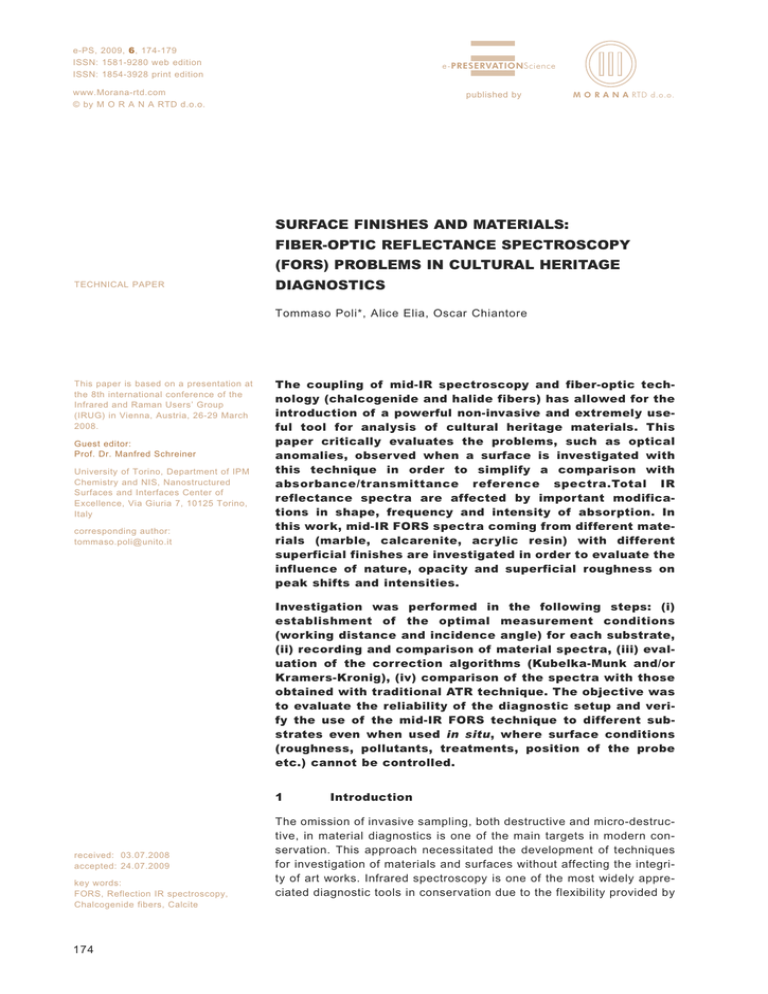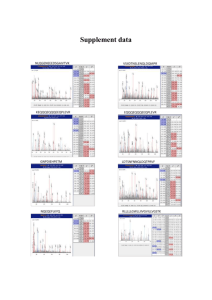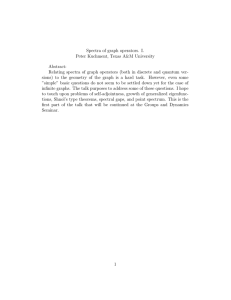e-PS, 2009, , 174-179 ISSN: 1581-9280 web edition e-PRESERVATIONScience
advertisement

e-PS, 2009, 6, 174-179 ISSN: 1581-9280 web edition ISSN: 1854-3928 print edition e-PRESERVATIONScience www.Morana-rtd.com © by M O R A N A RTD d.o.o. published by M O R A N A RTD d.o.o. SURFACE FINISHES AND MATERIALS: FIBER-OPTIC REFLECTANCE SPECTROSCOPY (FORS) PROBLEMS IN CULTURAL HERITAGE TECHNICAL PAPER DIAGNOSTICS Tommaso Poli*, Alice Elia, Oscar Chiantore This paper is based on a presentation at the 8th international conference of the Infrared and Raman Users’ Group (IRUG) in Vienna, Austria, 26-29 March 2008. Guest editor: Prof. Dr. Manfred Schreiner University of Torino, Department of IPM Chemistry and NIS, Nanostructured Surfaces and Interfaces Center of Excellence, Via Giuria 7, 10125 Torino, Italy corresponding author: tommaso.poli@unito.it The coupling of mid-IR spectroscopy and fiber-optic technology (chalcogenide and halide fibers) has allowed for the introduction of a powerful non-invasive and extremely useful tool for analysis of cultural heritage materials. This paper critically evaluates the problems, such as optical anomalies, observed when a surface is investigated with this technique in order to simplify a comparison with absorbance/transmittance reference spectra.Total IR reflectance spectra are affected by important modifications in shape, frequency and intensity of absorption. In this work, mid-IR FORS spectra coming from different materials (marble, calcarenite, acrylic resin) with different superficial finishes are investigated in order to evaluate the influence of nature, opacity and superficial roughness on peak shifts and intensities. Investigation was performed in the following steps: (i) establishment of the optimal measurement conditions (working distance and incidence angle) for each substrate, (ii) recording and comparison of material spectra, (iii) evaluation of the correction algorithms (Kubelka-Munk and/or Kramers-Kronig), (iv) comparison of the spectra with those obtained with traditional ATR technique. The objective was to evaluate the reliability of the diagnostic setup and verify the use of the mid-IR FORS technique to different substrates even when used in situ, where surface conditions (roughness, pollutants, treatments, position of the probe etc.) cannot be controlled. 1 received: 03.07.2008 accepted: 24.07.2009 key words: FORS, Reflection IR spectroscopy, Chalcogenide fibers, Calcite 174 Introduction The omission of invasive sampling, both destructive and micro-destructive, in material diagnostics is one of the main targets in modern conservation. This approach necessitated the development of techniques for investigation of materials and surfaces without affecting the integrity of art works. Infrared spectroscopy is one of the most widely appreciated diagnostic tools in conservation due to the flexibility provided by © by M O R A N A RTD d.o.o. the available measuring modes 1,2 (pellets, diamond anvil, DRIFT, ATR, total reflection and fibres) and the capability of material identification (both inorganic and organic). Mid-IR FORS (Mid-Infrared Fibre Optic Spectroscopy) permits us to exploit this flexibility directly on a work of art without sampling. 3-5 Optimization of this methodology may provide conservators with a tool for quick diagnostics during initial interventions, such as consolidation and cleaning. In order to achieve this objective it is necessary to study and characterize materials and substrates since reflection IR spectra suffer of some important spectral anomalies. IR total reflectance and FORS spectra are affected by important distortions in the shape, frequency and intensity of absorption: the so-called reststrahlen effect. The effect is prominent with opaque surfaces where specular and diffuse reflectance phenomena are in competition, giving rise to complex interactions related to the concentration of absorbing species, absorption coefficients, refraction indexes and surface roughness. Reflectance is correlated to the refraction index and the absorption coefficient of the investigated material: when in conjunction with strong absorption the former varies in an anomalous way getting near to the value of 1 (air value), peaks are characteristically deformed leading to inverted or derivative shape. an high open porosity (around 35 vol%) from southern Italy used in Sicilian baroque architecture. Candoglia marble is a xenoblastic methamorphic and carbonaceous stone, with a very low open porosity (<1 vol%) from northern Italy used in the cathedral of Milan. Paraloid B72 (ethylmethacrylate/methylacrylate, EMA/MA, Rohm and Haas) is a copolymer widely used in conservation, applied by brush using a 5% solution in acetone (Aldrich, for HPLC >99.9%). ATR spectra (5000-650 cm -1 , 64 scans, resolution 4 cm -1 ) have been recorded with a single-reflection ATR device ‘Smart Endurance’ with diamond contact crystal and ZnSe focusing element. The device was coupled with a Thermo-Nicolet Nexus FTIR Spectrometer with a DTGS detector. Reflection spectra (5000-650 cm -1 , 64 scans, resolution 4 cm -1 ) were recorded with a Nicolet Continuμm IR microscope with a 15x objective coupled with a Thermo-Nicolet Nexus FTIR spectrometer with an MCT detector. Mid-IR FORS spectra (5000-1000 cm -1 , 128 scans, resolution 4 cm -1 ) were recorded with Remspec chalcogenide fibres (19 fibres: 7 input and 12 output, 500 μm) coupled with a Remspec detector equipped with an MCT unit (InfraRed Associates Inc). The IR beam used was from the ThermoNicolet Nexus FTIR spectrometer. Moreover, combination bands, very weak in the transmission or ATR measurements, may become strong in reflectance experiments. In interpretation, this means that a deeper knowledge of the interactions and of absorption intensities is needed. Mid-IR spectra are reported in arbitrary absorbance units where absorbance, in the case of total reflectance and FORS measurements, is defined as log(1/R), where R is reflectance. In this paper, two stone materials, polished marble and calcarenite with high superficial roughness, have been characterized in an extended mid-IR range (1000 - 5000 cm -1 ) with total reflectance spectroscopy and with mid-IR FORS. The obtained spectra have been compared with ATR spectra in order to observe differences. After characterization, stone samples have been treated with an acrylic copolymer and investigated with the same techniques in order to verify if mid-IR FORS is able to reveal the presence of the polymer. Kramers-Kronig (KK) and Kubelka-Munk (KM) corrections were applied in order to examine their applicability and usefulness. 3 2 Materials and Methods Two Italian stones widely employed in historical buildings were chosen for their different morphologic characteristics but similar chemical compositions: Noto stone is a yellow organogenic calcarenite with Experimental The distance of the probe as well as its inclination and the sample surface roughness can heavily affect total reflectance spectra modifying the intensity of the signal and the ratio between the specular and diffuse components. 5 The measurement settings are even more important in fibre-optic spectroscopy. In situ measurements are often carried out in particular conditions where optimal probe positioning cannot be granted. In these cases, it becomes important to increase the signal in order to record a significant spectrum. With this objective a cylinder of aluminium foil has been wrapped around the probe and slid down during the measurements in order to reduce lateral radiation loss in the path from the tip of the probe to the sample. Energies have been checked at different distances and different incidence angles with respect to the surface, with and without the aluminium wrapping (Table 1). FORS of Surface Finishings and Materials in Cultural Heritage, e-PS, 2009, 6, x-y 175 www.e-PRESERVATIONScience.org Distance (mm) Max energy on aluminium mirror (gain 1) P Max energy on calcarenite (gain 8) CP P Max energy on aluminium mirror (gain 4) Angle (°) CP 9.7 Max energy on calcarenite (gain 1) P CP P CP 70 7.5 7.9 7.0 7. 3 contact 13.4 1 10.9 10.9 5.0 5.9 65 3.8 5.0 5.9 6. 5 2 8.0 8.5 3.8 4.7 55 0.7 3.8 3.8 4. 75 5 5.4 6.7 2.3 3.4 10 2.1 5.4 1.2 3.1 Table 1: Values of maximum energy vs. distance and vs. incidence angle with respect to the surface, for reference mirror and for calcarenite. (P - without the aluminium foil; CP - with aluminium foil). The measurements have been carried out on a polished aluminium surface, where high specular reflectance is expected, and on calcarenite, where the diffuse component becomes important. In the case of specular reflectance, a decisive gain due to the aluminium wrapping starts from 5 mm (around 24%). In the case of calcarenite the gain reaches 24% already at a distance of 2 mm: signal decreases due to the diffusion of the radiation; can be noticed as soon as the probe loses the contact with surface, so the effect of wrapping becomes quite immediately evident. With measurements at angle values lower than 90° with respect to the surface the situation is reversed with highest gains for specular conditions (Table 1) when the wrapping is applied. As predictable, the specular component is highly influenced by angle variations, whereas the diffuse component is less affected. This optimization aims at identifying the lower energy limit in the considered conditions for obtaining an interpretable mid-IR FORS spectrum. 4 The total reflection and FORS spectra highlight the different behaviours of the two surfaces: the marble spectra include a high specular component and a correlated reststrahlen band in correspondence to the intense ν 3 maximum of absorption (Figure 3). On calcarenite, diffuse reflectance becomes important and it is clearly observable in Figure 2 where the calcite powder and calcarenite mid-IR FORS spectra are compared. Even if the reststhralen effect dominates the calcarenite spectrum, the higher diffuse reflectance component allows for the enhancement of a larger number of characteristic bands (Table 2). Results and Discussion The two stone substrates have been characterized in ATR and in total reflection (Figure 1). The spectral range has been extended to 5000 cm -1 in order to include two calcite bands: an overtone and a combination band (3ν 3 and 2ν 3 +ν 1 ). 6-10 Figure 1: Marble (light blue line) and calcarenite (dark blue line) total reflection spectra and their main absorption peaks compared with typical transmission spectra absorption of calcite (red line). Calcarenite Marble ATR (cm-1) Reflection (cm-1) FORS (cm-1) Reflection (cm-1) FORS (cm-1) ν4 712 s 716 s - derivative 713 kk - ν2 876 s RS - 877 inv - ν1 1086 w - - - - ν3 1395 s RS RS RS RS ν1+ν4 1797 w 1797 s 1795 s 1801 w 1799 w ν1+ν3 2514 w 2513 s 2517 s 2518 s 2520 s 2ν3+ν1 - 3940 w 3943 w 3939 w 3944 w 3ν3 - 4274 w 4269 w 4262 w 4282 w Table 2: Calcarenite and marble absorption bands detectable with different techniques (kk - corrected value, inv – inverted, and RS - strong reststrahlen effect). 176 FORS of Surface Finishings and Materials in Cultural Heritage, e-PS, 2009, 6, x-y © by M O R A N A RTD d.o.o. The samples, once treated with Paraloid B72 have been characterized with mid-IR FORS, as mentioned above, in order to verify the methodology. The treatment with EMA/MA leads to only slight modifications of the spectra that can be observed in the ranges 1000-1800 cm -1 and 3800-4700 cm -1 (Figures 4 and 5). It was necessary to apply a smoothing procedure in order to reduce the noise including the following steps: - recording of 5 spectra (128 scans x 5 times) at the same point, - smoothing of spectra and peak comparison, - comparison of FORS spectra with those obtained in total reflection mode with the micro-FTIR objective. This confirmed that the spectra were sufficiently clean and reliable (Figures 4a, 4b, 5a and 5b). The previously recorded pure EMA/MA FORS spectra showed four signals at 4160, 4330, 4430 and 4682 cm -1 related to composition bands. In Figure 4a, the presence of polymer on calcarenite is shown Figures 2 and 3: Mid-IR FORS spectra of calcarenite, marble (red lines) and calcite powder (violet line) compared with related total reflection spectra (blue lines). Figures 4 and 5: Mid-IR FORS spectra of calcarenite and marble before (violet lines) and after (red lines) the treatment with EMA/MA with the main differences in the two highlighted areas. Figures 4a and 5a: Mid-IR FORS spectra of calcarenite (4a) and marble (5a) before (violet line) and after the treatment with EMA/MA (red line) in the range of 3800-4700 cm-1. FORS of Surface Finishings and Materials in Cultural Heritage, e-PS, 2009, 6, x-y 177 www.e-PRESERVATIONScience.org present. The reststrahlen effect tends to hide the ν 1 +ν 4 composition mode of the calcite. The C-O stretching bands are present but broadened and not clearly detectable. 5 Kramers-Kronig and other Corrections Reflectance is correlated with the refraction index and the absorption coefficient: when the former varies in anomalous way getting near to the value of 1 (air value) in conjunction with strong absorptions, peaks are characteristically deformed, e.g. inverted with of derivative shape. 11,12 When no interactions takes place, the correct relationship between the refraction index and the absorption coefficient can be reconstructed by applying the Kramers-Kronig (KK) correction, even if not all the theoretical assumptions hold. 13,14,15 In the case of the carbonate peak the correction cannot be applied: a reststrahlen band appears together with splitting of vibrational components. 3 In Figure 6, the KK correction worked well on the derivative band related to the carbonyl peak of EMA/MA, shifting the absorption maximum from 1753 cm -1 to the correct value of 1730 cm -1 , while in Fig. 4b and 5b: Mid-IR FORS spectra of calcarenite (4b) and marble (5b) before (violet line) and after the treatment with EMA/MA (red line) in the range of 1000-1800 cm-1. by the two peaks at 4330 and 4430 cm -1 , while the other two absorptions are drastically reduced. In Figure 5a the presence of polymer on marble is not clearly detectable: probably transflection effects reduce the intensities of composition bands. EMA/MA absorption in the spectral region of 10001800 cm -1 includes carbonyl stretching (1730 cm -1 ), C-H bending (1473 and 1446 cm -1 ), C-C vibration and C-O stretching (1237 and 1267 cm -1 ). In Figure 4b, the presence of the polymer on calcarenite is evident due to the carbonyl derivative peak with the maximum at 1745 cm -1 and by the C-O streching at 1237 cm -1 and its shoulder at 1271 cm -1 . In Figure 5b, the presence of the polymer on marble is detected by the presence of the carbonyl band (1730 cm -1 ) that reveals even more clearly its derivative nature due to the higher specular component 178 Figure 6: Mid-IR FORS spectrum of the treated marble in the range of 1000-1900 cm-1 before (red line) and after KK correction (blue line). Figure 7: FORS spectrum of the treated calcarenite in the range of 1000-1900 cm-1 before (red line) and after KK correction (blue line). FORS of Surface Finishings and Materials in Cultural Heritage, e-PS, 2009, 6, x-y © by M O R A N A RTD d.o.o. ing at 1237 cm-1 and its shoulder at 1271 cm-1, apart from the well assessed carbonyl peak. Figure 8: Mid-IR FORS spectrum of treated calcarenite in the range of 1000-5000 cm-1 before (red line) and after KM correction (blue line). the case of the carbonate band a pseudo-derivative band is generated at 1554 cm -1 . Kramers-Kroning (KK) algorithm is not able to reestablish the correct relationship between refraction index and absorption coefficient when other phenomena, such as the splitting of vibrational components, takes place together with the restrahlen effect. In the case of the treated calcarenite (Figure 7), specular component is less prominent, and so is reststrahlen effect, and the correction does work. It fails in revealing the carbonyl peak of polymer at 1730 cm -1 . the the not the The presence of a diffuse component in reflectance, especially on calcarenite, suggests the use of pseudo-absorbance Kubelka-Munk (KM) scale, not to correct anomalous dispersion features or attempt any quantitative evaluation but only in order to enhance absorption at higher wavenumbers and facilitate comparison among different spectra, even if correctness of this operation has yet to be evaluated 16 since we are not working in diffuse reflectance conditions. Even if applied ‘improperly’ in a way, KM correction allows the detection of the presence of characteristic absorptions at high wavenumbers (3800 - 4500 cm -1) on the treated calcite, as evident in Figure 8. 5 Conclusion A simple method for enhancement of mid-IR FORS signals in less than optimal operative conditions has been successfully applied. The differences in FORS spectra between marble and calcarenite have been investigated extending the analysis to bands between 3800 and 4500 cm-1 in order to consider the two peaks of calcite at 3943 and 4274 cm-1 (a combination band and an overtone). In the case of EMA/MA treatment, three polymer peaks have been considered and characterized: 4330, 4430 cm-1, C-O strech- Finally, the effect of different corrections, such as Kramers-Kronig and Kubelka-Munk has been evaluated in order to permit a more immediate and reliable comparison with reference transmission spectra. MidIR FORS characterization of stone substrates and treatments will continue with the introduction of new substrates, such as sandstone and with the utilization of new halide fibers with a different spectral efficiency particularly at lower wave numbers. Further studies will be focused on the identification of the treatments in presence of most common pollutants and degradation products of stone substrates such as sulphates and oxalates. 6 References 1. M.T. Doménech Carbó, F. Bosch Reig, J.V. Gimeno Adelantado, V. Periz Martinez, Fourier transform infrared spectroscopy and the analytical study of works of art for purposes of diagnosis and conservation, Anal. Chim. Acta, 1996, 330, 207-215. 2. L. Toniolo, F. Casadio, The analysis of polychrome works of art: 40 years of infrared spectroscopic investigations, J. Cult. Her., 2001, 2, 71-78. 3. C. Ricci, C. Miliani, B. Brunetti, A. Sgamellotti, Non-invasive identification of surface materials on marble artifacts with fiber optic midFTIR reflectance spectroscopy, Talanta, 2006, 69, 1221-1226. 4. C. Miliani, B. Brunetti, A. Sgamellotti, F. Rosi, P. Benedetti, I. Borgia, Fiber-optic Fourier transform mid-infrared reflectance spectroscopy: a suitable technique for in –situ studies of mural paintings, Appl. Spectrosc., 2007, 61, 293-299. 5. M. Fabbri, M. Picollo, S. Porcinai, M. Bacci, Mid-infrared fiberoptics reflectance spectroscopy: a non invasive technique for remote analysis of painted layers. Part I: technical setup, Appl. Spectrosc., 2001, 55, 420-427. 6. S. Gunasekaran, G. Anbalagan, Spectroscopic characterization of natural calcite minerals, Spectrochim. Acta A, 2007, 68, 656-664. 7. J.W. Ellis, The near infrared absorption spectra of calcite, Physics, 1930, 16, 315-320. 8. E.B. Plyler, The near infrared absorption spectra of calcite and strontiatite, Phys. Rev., 1929, 33, 948-951. 9. S. Silverman, Concerning the absorption and reflection spectra of calcite in the infrared, Phys. Rev., 1932, 39, 72-76. 10. E. Libowitzty, G.R. Rossman, Principles of quantitative absorbance measurements in anisotropic crystals, Phys. Chem. Minerals, 1996, 23, 319-327. 11. E.H Korte, A. Roseler, Infrared reststrahlen revisited: commonly disregarded optical details related to n<1, Anal. Bioanal. Chem., 2005, 382, 1987-1992. 12. E.H Korte, A. Roseler, Reflection anomalies related to n=1 , Vibr. Spectrosc., 2007, 43, 111-115. 13. K. Yamamoto, H. Ishida, Kramers-Kronig analysis applied to reflection-absorption spectroscopy, Vibr. Spectrosc., 1997, 15, 2736. 14. P. Grosse, V. Offermann, Analysis of reflectance data using the Kramers-Kronig relations, Appl. Phys. A, 1991, 52, 138-144. 15. S. Ng, Z. Hassan, H. Abu Hassan, Kramers-Kronig analysis of infrared reflectance spectra, Jurnal Teknology, 2006, 44, 67-76. 16. W. E. Vargas, G. A. Nicklasson, Applicability conditions of the Kubelka-Munk theory, 1997, 36, 22, 5580-5586. FORS of Surface Finishings and Materials in Cultural Heritage, e-PS, 2009, 6, x-y 179



